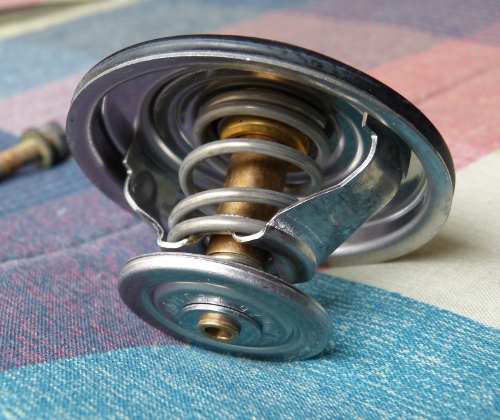Saturday, December 22, 2012
Thermostat Housing Leak
Last night I hopped in the car to head home from work in advance of the long holiday weekend and the OBC illuminated with the familiar “Coolant Level Low” message. When I popped the hood and took a peek in the expansion tank I could clearly see the top of the coolant level sensor – proof positive it wasn't a sensor problem. I didn't have any coolant with me, obviously, but I knew from experience that when the coolant level sensor trips there is still more than enough coolant remaining in the system...provided the system isn't leaking. A quick look around the front end with an obscenely bright small LED flashlight showed the telltale signs of coolant leaking around the thermostat housing, down the front of the block and onto the power steering hoses and swaybar. I used a spare rag to wipe the area down so I could later gauge the extent of the leak.
 I'd seen this movie before so I vowed to watch
the coolant temperature gauge as carefully as I would the turbine inlet temperature
while leaning a high performance aircraft engine, and headed home. I noticed
pretty early on in the drive that the heat was working perfectly. Had that
not been the case I might have pulled over and called a tow truck, as that
would have likely indicated a more severe loss of coolant.
I'd seen this movie before so I vowed to watch
the coolant temperature gauge as carefully as I would the turbine inlet temperature
while leaning a high performance aircraft engine, and headed home. I noticed
pretty early on in the drive that the heat was working perfectly. Had that
not been the case I might have pulled over and called a tow truck, as that
would have likely indicated a more severe loss of coolant.
I stopped at my garage on the way home, grabbed my bottle of 50/50 premixed BMW OE coolant I keep on hand to service the system and brought the level up to a point slightly over the divider visible through the hole in the expansion tank. This is the level I know from experience will result in a coolant level near the “Kalt/Cold” level imprinted on the side of the tank when the engine cools down. The remainder of the drive home was uneventful.
Once home I did some research to verify if I could install the Zionsville metal thermostat housing I had on hand from the last time I was faced with a need to replace the thermostat housing. At that time I decided against the metal unit because I lacked the proper flat gasket to use it, so the plan was to buy the gasket as well as a new thermostat and install the metal housing this time around. Some recent postings on bimmerforums, however, convinced me to change that plan.
It turns out that the quality of the housings produced after 2009 or so are not up to par and are prone to leaks. Several people also reported smelling coolant with no obvious signs of leaks, prompting some to consider the possibility that the porous quality of the castings results in a sort of osmosis process. The idea isn't as crazy as it sounds, since I know all too well it doesn't take much coolant to produce that smell. Since I knew I'd have absolutely no time to pull this again in the next few months I decided to go with the OE housing and thermostat again.
This morning I went out to the car to take a look at the coolant level and found it exactly where it should be – at the cold mark, so that reassured me that I was dealing with a slow leak. Still, I had plans to do a good amount of driving over the holiday weekend and with the threat of light snow at some point in the next few days I didn't want to risk bringing out the E46. So I switched gears and drove over to the dealer to pick up a thermostat housing, thermostat & o-ring, profile gasket, and a couple gallons of coolant -- one for topping off what I'd drain to replace the thermostat and another for my stock. I swapped the parts, refilled with a 50/50 mix of coolant and distilled water, washed down the front of the engine with plain water in about an hour and a half and drove home victorious.
The last thermostat housing I replaced in 2009 only gave me 30K miles in service. That was about half the lifespan of the preceding units and I never did figure out why that unit failed so quickly. The unit I replaced today was in service 58K miles so based on this and other experiences online I've decided to reduce my service interval on the thermostat housing (and thermostat, naturally, since you simply don't replace one without the other) to 55K miles.
Parts were $112 and I saved roughly $150 in labor and $25 in parts this time around.
Mileage: 229423, Parts: $112, Labor Saved: $150, Parts Saved: $25



